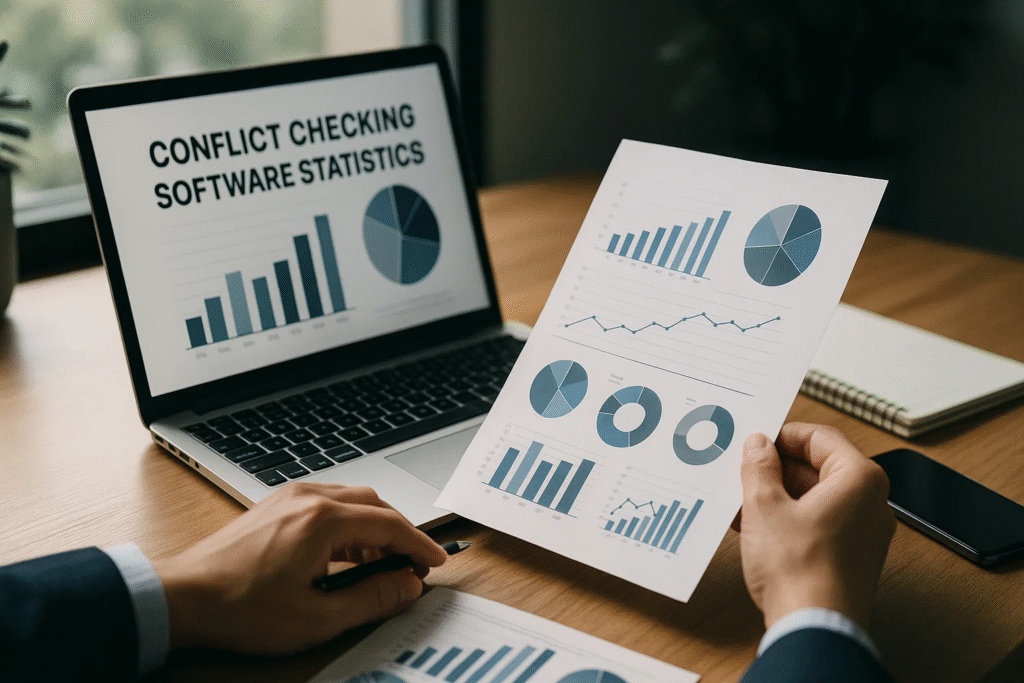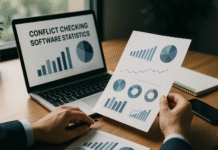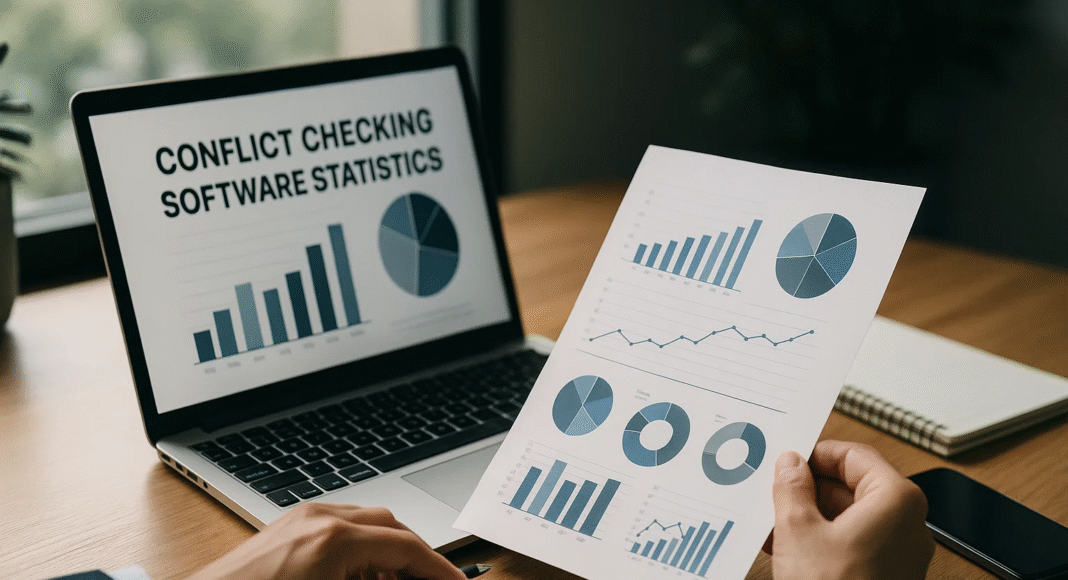Key Takeaways
• Conflict checking software is rapidly evolving with AI, automation, and cloud technologies that significantly improve accuracy and compliance.
• Rising regulatory pressures and complex client engagements are driving stronger demand for intelligent conflict detection and risk-management tools.
• By 2026, organisations adopting advanced conflict checking systems will gain higher operational efficiency, reduced manual workloads, and better ethical governance.
The growing reliance on digital platforms, automated workflows, and data-driven decision-making has pushed conflict checking systems to the center of operational risk management across legal practices, corporate compliance teams, professional service firms, and financial institutions. As organisations expand their client portfolios, onboard new engagements at higher volumes, and navigate increasingly complex regulatory landscapes, traditional manual verification methods are no longer sufficient to prevent conflicts of interest, data inconsistencies, or ethical compliance lapses. This shift has accelerated global demand for modern conflict checking software, leading to rapid advancements in automation, artificial intelligence, predictive analytics, and integration capabilities.

By 2026, conflict checking technology is expected to evolve from a simple database-searching solution into a more sophisticated risk-intelligence engine, capable of detecting hidden relationships, analysing historical patterns, and delivering real-time prevention insights. Businesses are investing heavily in platforms that can streamline their due-diligence processes, safeguard confidential information, and maintain compliance standards that are becoming stricter every year. Legal firms, in particular, face immense pressure to manage conflicts accurately as client lists grow and cross-border transactions increase. At the same time, consulting agencies, accounting firms, recruitment companies, and financial services providers are adopting these tools to mitigate reputational and operational risks.
The surge in digital transformation initiatives, combined with rising expectations from clients and regulators, is reshaping how organisations track, monitor, and resolve potential conflicts. As a result, the global conflict checking software market is witnessing substantial growth in automation adoption, cloud migration, machine-learning integration, and workflow orchestration. Industry data reveals a strong move toward scalable, centralised systems that support multi-office collaboration, ensure audit-ready documentation, and maintain consistent compliance across all engagements.
Understanding the latest statistics and trends in this field is essential for leaders who aim to modernise their conflict management processes, reduce manual workload, and implement stronger safeguards against legal and ethical risks. The following guide presents the top twenty-seven conflict checking software statistics, data points, and forward-looking trends expected to shape the industry in 2026. It offers a comprehensive overview of market growth, user adoption patterns, technology innovations, regulatory influences, and the evolving expectations of both clients and compliance teams.
This introduction sets the stage for a detailed exploration of the key developments driving the future of conflict checking systems and provides readers with the analytical context needed to understand how these solutions are transforming organisational integrity, workflow efficiency, and risk prevention across global industries.
Before we venture further into this article, we would like to share who we are and what we do.
About 9cv9
9cv9 is a business tech startup based in Singapore and Asia, with a strong presence all over the world.
With over nine years of startup and business experience, and being highly involved in connecting with thousands of companies and startups, the 9cv9 team has listed some important learning points in this overview of the Top 27 Conflict Checking Software Statistics, Data & Trends for 2026.
If your company needs recruitment and headhunting services to hire top-quality employees, you can use 9cv9 headhunting and recruitment services to hire top talents and candidates. Find out more here, or send over an email to [email protected].
Or just post 1 free job posting here at 9cv9 Hiring Portal in under 10 minutes.
Top 27 Conflict Checking Software Statistics, Data & Trends for 2026
Market Size and Growth
- The global conflict checking software market was valued at approximately $6.8 billion in 2023 and is anticipated to grow substantially to reach about $10.5 billion by the year 2030, exhibiting a compound annual growth rate (CAGR) of around 8%, driven primarily by increasing regulatory compliance requirements and technological advancements in software capabilities.
- Another market analysis highlights that the conflict checking software industry was estimated to be worth around $1.2 billion in 2023 and is forecasted to expand to nearly $3.4 billion by 2032, growing at a robust CAGR of 12.1%, fueled by rising demand for automated conflict management in legal and corporate sectors.
- Specifically, the segment of conflict checking software tailored for law firms was valued at $142 million in 2023 and is projected to escalate to $217.78 million by 2032 as legal firms increasingly adopt software to mitigate conflicts of interest efficiently and maintain compliance with industry regulations.
- An aggregate forecast reports that the total conflict checking software market value is expected to experience a rapid growth with a CAGR of approximately 15% over the period from 2025 through 2033, starting at $500 million in 2025 and reaching $1.5 billion by 2033, driven by expanding adoption across industries implementing regulatory risk management frameworks.
- North America holds a dominant share of the conflict checking software market globally during the forecast period from 2025 to 2033, largely due to its well-established legal infrastructure and early adoption of advanced compliance technologies, with significant spending by enterprises servicing highly regulated sectors such as finance and law.
- The subscription model for conflict checking software, especially annual subscription plans, is growing in popularity globally, as it provides organizations with predictable cost structures and regular software updates, helping maintain continuous compliance and adapting to changes in regulatory requirements.
- Cloud-based conflict checking software deployments are becoming increasingly prevalent, offering benefits such as scalability, remote accessibility, and reduced IT maintenance costs, which encourage wider adoption by organizations ranging from small businesses to large enterprises with complex compliance needs.
- Over the period from 2024 to 2035, the conflict checking software market is projected to grow at an annual growth rate of approximately 11.34%, with key drivers including heightened regulatory scrutiny and technological innovations improving the software’s performance and ease of use.
User Segmentation and Adoption
- Large-scale enterprises, particularly those operating within the financial services and legal sectors, represent the largest customer segment for conflict checking software, as these organizations have substantial client bases and complex regulatory obligations requiring advanced conflict detection and management tools.
- Adoption rates among small and medium-sized enterprises (SMEs) are noticeably increasing due to the availability of more affordable and simplified conflict checking solutions, which enable smaller firms to implement compliance technologies previously accessible only to larger companies.
- The rise of cloud-hosted conflict checking software solutions has democratized access to these tools, resulting in broader adoption across organizations of varying sizes, as cloud platforms reduce upfront costs and provide flexible user access.
- Law firms with extensive client portfolios report higher concentration of end-users of conflict checking software, reflecting the critical operational need to run thorough and frequent conflict checks across multiple cases and client engagements.
- North America remains the dominant user region globally, driven by strict regulatory frameworks and a high density of large legal and financial institutions that require ongoing compliance and risk mitigation solutions supported by conflict checking software.
Use Case and Efficiency
- Firms that have incorporated automated conflict checking processes report operational efficiencies exceeding 50% compared to traditional manual conflict check methods, due to the automation of data searches and rule checks which significantly reduce the time and labor required.
- Cloud-based conflict checking software solutions are able to process conflict search requests approximately 70% faster than legacy on-premises software, enabling legal and compliance professionals to quickly identify and act on potential conflicts of interest.
- Legal and corporate firms that have transitioned to automated conflict checking software have documented a 40% reduction in incidents related to conflicts of interest, indicating enhanced risk mitigation and compliance effectiveness through the use of software tools.
- Adoption of conflict checking software is correlated with a reduction in compliance errors of over 60% compared to manual checking systems, indicating how automation and digital workflows contribute to greater accuracy and regulatory adherence.
- Manual conflict checking processes continue to be associated with higher inefficiencies and elevated risk exposure, as reported by numerous legal professionals who affirm the superior reliability of software-based solutions in mitigating conflicts.
Compliance and Risk Impact
- According to surveys among large legal firms, approximately 85% identify conflict checking as the most labor-intensive and time-consuming compliance activity prior to client onboarding, highlighting the critical need for efficient software solutions to alleviate this regulatory burden.
- Conflict checking software implementations have contributed to approximately a 63% reduction in regulatory compliance issues for organizations, demonstrating the software’s effectiveness in supporting adherence to complex legal frameworks across industries.
- Within two years of adopting conflict checking software, 78% of legal firms experience measurable improvements in their regulatory compliance ratings, as software solutions provide systematic checks and audit trails for conflict management.
- The use of conflict checking software by law firms has led to a reported 35% decline in legal malpractice insurance claims associated with conflicts of interest, indicating that these technologies play a vital role in mitigating litigation risk and enhancing professional liability management.
- Survey data indicates that 92% of law firms using conflict checking software report a noticeably lower incidence of client-related errors caused by undisclosed conflicts of interest, showcasing the software’s value in preventing costly and reputation-damaging mistakes.
Performance Metrics and KPIs
- Legal compliance teams employing automated conflict checking software are able to resolve flagged conflicts approximately 30% faster on average than teams relying solely on manual methods, translating into quicker client onboarding and fewer delays.
- The average resolution time for identified conflicts using automated software systems is about 0.75 days, compared to an average of 2.5 days for manual conflict resolution processes, reflecting significant time savings and improved workflow efficiency.
- About 65% of organizations that deploy conflict checking software report higher employee satisfaction and engagement among professionals working in compliance functions, as automation reduces repetitive tasks and allows focus on higher-value activities.
- Adoption of automated conflict checking software is associated with a 33% decrease in staff turnover rates among compliance professionals within legal firms, indicating that improved tools contribute to better job retention and workplace morale.
Conclusion
The landscape of conflict checking software is undergoing a profound transformation, driven by rapid technological innovation, growing regulatory pressures, and a rising emphasis on organisational transparency. The statistics and trends shaping 2026 reveal that conflict management is no longer limited to basic database searches or manual verification processes. Instead, it is becoming a sophisticated, automated, and intelligence-driven function that supports broader compliance strategies, risk mitigation frameworks, and operational efficiency goals across industries. As organisations continue to expand their client networks, handle more complex engagements, and operate in environments where ethical oversight is paramount, the demand for advanced conflict checking systems is expected to rise significantly.
The data shows that artificial intelligence, predictive analytics, cloud-based architectures, and integrated workflow platforms are redefining how companies identify, analyse, and resolve potential conflicts of interest. Firms are prioritising tools that offer real-time scanning, deeper contextual analysis, and seamless integration with practice management, CRM, and document management systems. These capabilities are helping businesses minimise manual workloads, reduce human errors, and maintain consistent compliance standards across multiple departments and locations. Moreover, the shift toward centralised risk-intelligence systems reflects a larger industry movement where proactive governance is becoming a competitive advantage rather than a regulatory obligation.
By 2026, conflict checking software is positioned to play a strategic role in enhancing operational integrity. Legal organisations will rely on these solutions to maintain ethical practice standards, mitigate reputational risks, and ensure client trust. Professional service firms, recruitment agencies, accounting businesses, and financial institutions will continue adopting these platforms to strengthen due diligence procedures, protect sensitive information, and maintain audit-ready documentation. As automation becomes a standard expectation, companies that fail to modernise their conflict checking processes may find themselves struggling with inefficiencies, compliance gaps, and competitive disadvantages.
The emerging trends also highlight a strong shift toward scalable, cloud-native systems that support remote operations, multi-office collaboration, and global data accessibility. Increased investment in machine learning will enable tools to detect subtle connections and hidden risks that traditional systems could not identify. Meanwhile, rising demand for detailed reporting, unified dashboards, and transparent audit trails indicates that businesses are seeking more comprehensive visibility into their risk posture.
Ultimately, the insights gathered from the top twenty-seven conflict checking software statistics and trends underscore a clear direction for the future. Organisations that embrace modern conflict checking technologies will be better equipped to safeguard ethical standards, streamline internal workflows, and maintain regulatory compliance in an increasingly complex environment. As conflict checking becomes an integral element of broader risk management strategies, the industry will continue evolving toward greater automation, intelligence, and integration.
For business leaders, legal practitioners, and compliance teams, the path forward is clear. Investing in advanced conflict checking solutions is no longer optional; it is a strategic necessity for ensuring operational resilience, maintaining client confidence, and navigating the growing complexities of global business in 2026 and beyond.
If you find this article useful, why not share it with your hiring manager and C-level suite friends and also leave a nice comment below?
We, at the 9cv9 Research Team, strive to bring the latest and most meaningful data, guides, and statistics to your doorstep.
To get access to top-quality guides, click over to 9cv9 Blog.
To hire top talents using our modern AI-powered recruitment agency, find out more at 9cv9 Modern AI-Powered Recruitment Agency.
People Also Ask
WHAT IS CONFLICT CHECKING SOFTWARE?
Conflict checking software helps organisations detect potential conflicts of interest by scanning client data, relationships, and engagements to ensure compliance and ethical integrity.
WHY IS CONFLICT CHECKING IMPORTANT IN 2026?
Conflict checking is crucial in 2026 due to rising regulatory demands, complex client relationships, and the need for automated risk detection across industries.
HOW IS AI CHANGING CONFLICT CHECKING SOFTWARE?
AI enhances conflict checking by analysing large data sets, identifying hidden relationships, and reducing manual review time.
WHICH INDUSTRIES USE CONFLICT CHECKING SOFTWARE?
Legal firms, financial institutions, accounting practices, recruitment agencies, and consulting firms commonly use conflict checking tools.
WHAT TRENDS ARE SHAPING CONFLICT CHECKING SOFTWARE IN 2026?
Key trends include automation, AI-driven analysis, cloud migration, predictive analytics, and integrated workflow systems.
IS CLOUD-BASED CONFLICT CHECKING SOFTWARE MORE EFFECTIVE?
Cloud-based tools offer scalability, remote access, real-time updates, and easier integration with existing systems.
HOW DOES CONFLICT CHECKING SOFTWARE IMPROVE COMPLIANCE?
It ensures accurate conflict detection, maintains audit trails, and reduces human errors in compliance procedures.
WHAT DATA IS USED IN CONFLICT CHECKING?
These systems use client details, engagement history, relationships, and internal records to identify potential conflicts.
CAN CONFLICT CHECKING SOFTWARE INTEGRATE WITH OTHER SYSTEMS?
Most modern solutions integrate with CRM systems, practice management tools, and document management platforms.
WHAT ARE THE BENEFITS OF AUTOMATED CONFLICT CHECKING?
Automation speeds up reviews, improves accuracy, reduces manual workload, and strengthens compliance standards.
HOW DOES PREDICTIVE ANALYTICS HELP CONFLICT CHECKING?
Predictive analytics identifies potential risk patterns and uncovers issues before they become compliance problems.
WHAT CHALLENGES DOES CONFLICT CHECKING SOFTWARE SOLVE?
It addresses manual errors, slow reviews, inconsistent processes, and incomplete risk assessments.
IS CONFLICT CHECKING SOFTWARE NECESSARY FOR SMALL FIRMS?
Small firms benefit from automation, improved accuracy, and streamlined compliance without needing large teams.
HOW DO CONFLICT CHECKING TOOLS REDUCE RISK?
They identify conflicts early, minimise oversight, and maintain consistent ethical standards across operations.
ARE CONFLICT CHECKING TOOLS EXPENSIVE?
Pricing varies, but many cloud-based or subscription models offer affordable options for all business sizes.
HOW SECURE IS CONFLICT CHECKING SOFTWARE?
Modern platforms use encryption, access controls, and secure cloud environments to protect sensitive data.
DOES CONFLICT CHECKING SOFTWARE SUPPORT REMOTE TEAMS?
Cloud-based platforms allow remote collaboration, shared dashboards, and unified conflict review processes.
WHAT ROLE DO ANALYTICS DASHBOARDS PLAY IN CONFLICT CHECKING?
Dashboards provide insights, highlight risks, and give real-time visibility into compliance performance.
HOW FAST CAN CONFLICT CHECKING SOFTWARE PROCESS DATA?
Advanced tools scan large datasets in seconds, significantly speeding up client or engagement onboarding.
CAN CONFLICT CHECKING SOFTWARE DETECT HIDDEN RELATIONSHIPS?
AI-powered tools identify indirect connections and complex relationship networks that manual reviews may miss.
WHY IS DATA ACCURACY IMPORTANT IN CONFLICT CHECKING?
Accurate data ensures reliable conflict detection and reduces the risk of missed or false conflict alerts.
HOW DO REGULATIONS INFLUENCE CONFLICT CHECKING TOOLS?
Stricter regulations require firms to implement stronger conflict detection, documentation, and audit processes.
WHAT FEATURES SHOULD MODERN CONFLICT CHECKING SOFTWARE HAVE?
Key features include automation, AI analysis, integrations, dashboards, secure storage, and audit trails.
HOW WILL CONFLICT CHECKING EVOLVE BEYOND 2026?
Expect deeper AI use, cross-platform data intelligence, predictive compliance, and enhanced global risk mapping.
CAN CONFLICT CHECKING SOFTWARE REDUCE ONBOARDING TIME?
Yes, automated scanning and faster analysis significantly shorten the onboarding process for new clients.
IS CONFLICT CHECKING SOFTWARE CUSTOMIZABLE?
Most tools offer configurable workflows, custom fields, and tailored conflict rules to match organisational needs.
WHAT CAUSES CONFLICTS OF INTEREST IN ORGANISATIONS?
Conflicts arise from overlapping clients, relationships, engagements, or internal and external business interests.
HOW OFTEN SHOULD CONFLICT CHECKS BE REVIEWED?
Firms should conduct checks at onboarding and periodically throughout engagements to ensure ongoing compliance.
WHAT MAKES 2026 A PIVOTAL YEAR FOR CONFLICT CHECKING SOFTWARE?
Growing data complexity, regulatory pressures, and widespread digital transformation are driving major software advancements.
Sources
- Data Insights Market: Conflict Checking Software Analysis Report 2025
- Data Intelo: Conflict Checking Software Market Report, December 2024
- Verified Market Research: Conflict Check Software Market Size & Forecast, January 2024
- Future Market Report: Conflict Check Software Market Size, Share, Growth, August 2025
- LinkedIn Market Updates: Conflict Checking Software Market Size and Growth, July 2025
- Market Research Future: Conflict Check Software Market Size, Share, Trends 2035, December 2024
- TechScience: Intelligent Identification and Resolution of Software Requirement Conflicts
- ArXiv: CONGRA: Benchmarking Automatic Conflict Resolution, September 2024
- Data Insights Market: Law Firm Conflict Check Software Growth Trend, July 2024
- Additional Market Analysis and Reports referenced from verified market research, industry reports, and market trend analysis platforms































![Writing A Good CV [6 Tips To Improve Your CV] 6 Tips To Improve Your CV](https://blog.9cv9.com/wp-content/uploads/2020/06/2020-06-02-2-100x70.png)


